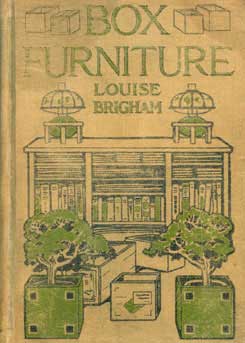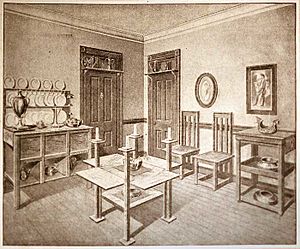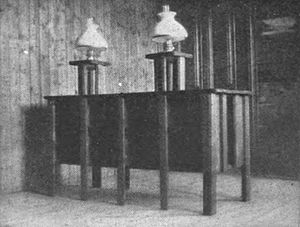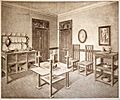Louise Brigham facts for kids
Quick facts for kids
Louise Brigham
|
|
|---|---|
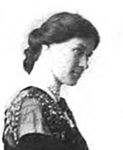 |
|
| Born | January 10, 1875 Boston, Massachusetts, U.S.
|
| Died | March 30, 1956 (aged 81) Trenton, New Jersey, U.S.
|
| Nationality | American |
| Other names | Louise Brigham Chisholm |
| Occupation | designer, teacher |
| Spouse(s) | Henry Arnott Chisholm (steel company executive) |
Louise Brigham (born January 1, 1875 – died March 30, 1956) was an American designer and teacher from the early 1900s. She was a pioneer in using recycled materials to make furniture. Louise invented a special way to build furniture from old packing crates. This was one of the first times someone used a "modular" system, where small parts could be put together in different ways.
She also started one of the first companies for ready-to-assemble furniture. This means furniture you buy in pieces and put together yourself. Louise also created the Home Thrift Association (HTA). This group taught woodworking skills to boys in New York City. In 1940, she received an award from the HTA for her 25 years of hard work.
Contents
Early Life and Learning
Louise Ashton Brigham was born in Boston. She was the fourth of five children. Sadly, her mother died when Louise was only two years old. She also lost her father when she was 19.
Louise studied art and design in New York. She attended the Pratt Institute and the Chase School of Art. This school is now known as Parsons The New School for Design. She also studied art in Europe.
Her Amazing Career
In the late 1890s, Louise Brigham joined the settlement movement. This movement helped people in poor neighborhoods. She opened Sunshine Cottage in Cleveland, Ohio. In 1900, records show she worked as a teacher and "settlement worker" at Hiram House in Cleveland.
Travels and Ideas
When Louise was in her early 30s, she traveled a lot in Europe. She spent about five years there, from 1905 to 1910. She learned different kinds of handcrafts from artists and local people in many countries. She visited places like the Netherlands, Germany, Denmark, and Sweden.
Two summers she spent on the Norwegian island of Spitsbergen were very important. This island is far north, above the Arctic Circle. Louise was in a coal-mining camp there. The camp had 80 men, and conditions were very basic. Food and supplies had to be brought by ship in summer. This meant there were huge piles of empty packing crates.
In this tough environment, Louise started designing "box furniture." She used these old packing crates to make furniture for the camp. This was a new idea she had been trying out.
Furniture from Boxes
In 1909, Louise Brigham published a book called Box Furniture. It showed her designs for making furniture only from packing crates. The book had drawings by Edward H. Aschermann.
Box Furniture was a how-to guide for people who wanted to build their own furniture. It had many different furniture plans. It also gave advice on how to choose and take apart crates. The book taught basic carpentry skills and listed the tools needed. Louise even suggested ideas for curtains and colors to go with the furniture.
Louise used recycled materials that were very cheap. Many of her designs were multi-purpose and saved space. For example, she designed a drop-leaf table and nesting stools. These were perfect for people living in small city apartments. Some of her pieces were modular. This meant smaller parts could be used alone or combined to make bigger pieces.
Louise's ideas were very modern for her time. She combined new design with a "do-it-yourself" approach. This was unusual then, but it was a step towards today's "green design" movement. Her project was seen as a complete system with a design idea and a social goal.
Home Thrift Association
In 1910, Louise showed a child's room made entirely of box furniture. It was at a Child Welfare Exhibit in New York City. City officials were impressed. They offered Louise the use of Gracie Mansion, a large house. Louise accepted and started the Home Thrift Association (HTA) there. It was a woodworking "laboratory" for boys.
She explained, "We give each boy a set of seven simple tools and show him how to start. Then he does the rest." The HTA later welcomed girls too. Its goal was to teach thrift and help families.
The club quickly grew too big for Gracie Mansion. It had about 600 students in its first year! So, it moved to a new location. Louise furnished her own apartment almost completely with box furniture made by the HTA students. It was like a model showroom. The total cost for the furniture in her apartment was only about $4. This was less than half of what an average worker earned in a week back then.
Ready-to-Assemble Furniture
During World War I, Louise Brigham opened a box furniture factory in New York. It aimed to make affordable furniture and create jobs for workers. Later, it was given to the YMCA to help soldiers returning from the war.
Around the same time, Louise and two partners started Home Art Masters. This was a mail-order business. They sold ready-to-assemble furniture kits. These kits came with instructions so people could build the furniture at home with simple tools. This business was many years ahead of its time. Modern ready-to-assemble furniture became popular much later.
Later Years
Because of Louise's teaching at the HTA and the attention her work received, box furniture became quite popular before World War I. Her book was printed many times and translated into other languages.
On August 21, 1916, Louise married Henry Arnott Chisholm. He was 64 years old. Henry Chisholm died in 1920. In the years after, Louise worked on a new edition of her book, but it was never published. She also wrote a memoir, which is now lost. In the 1930s, she followed the American healer Edgar Cayce. Louise Brigham died in Trenton, New Jersey, on March 30, 1956.
Awards and Honors
- 1940: She received a medal from the Home Thrift Association (HTA). This was to honor her 25 years of service to the organization she started.
Images for kids
See also
 In Spanish: Louise Brigham para niños
In Spanish: Louise Brigham para niños


